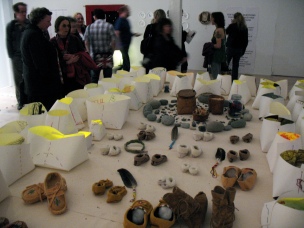Peter Morin is a visual and performance artist of the Crow clan of the Tahltan Nation. Morin describes his series of performances, 12 Making Objects: 12 Indigenous interventions a.k.a First Nation’s DADA, as “finding ways to address the history of the Residential Schools and the effect of these schools on the aboriginal community and memory.” Morin’s performances acknowledge the pain and struggle caused by the Residential schools in history that is still present in our culture today. This work addresses the past, land stolen, children stolen, but his work honors the memory by creating ceremony through performance to connect with Aboriginal experiences.
Morin uses objects and actions to communicate and transform the gallery spaces and all the objects are left on display; Morin covered a copy of the 1876 Indian Act in animal fat,
made button blankets adorned with braided hair
imprinted moccasin tongues on the walls
drew with salt and tobacco salmon swimming
performed a telephone call to Joseph Beuys
smudged cedar smoke
fried bannock for everyone
cut his hair off while reciting all the words he knows in Tahltan
told stories about his grandmother by reading a deerskin jacket
constructed a tent of branches, string and bunting
danced, wearing layers of red blindfolds to “every breath you take” by P. Diddy

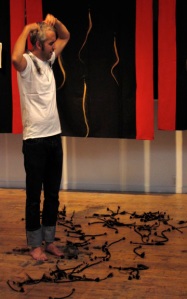

Morin’s actions and objects energize the gallery space. The blindfold dance reveals stories in an interior landscape and under these stories, more stories, aboriginal strata, flora and fauna. Perhaps the beaded deerskin jacket is a living leather letter written by a grandmother to a stolen child; it is a story we can only read with our hands. Perhaps the raw small stick tent is a counter-structure to the residential schools; we can experience an entire leafy encampment in place of bricks and plaster. Perhaps in cutting his hair Morin frees a stone of loss and grief – while pinning the braided hair onto the button blankets is a re-attachment to glory and culture. The salt, tobacco, cedar and sage smoke mingle and intervene in the space and speaking Tahltan words out-loud inverts the space; the words are like bling. And perhaps the soft moccasins, tongues and sole, rhythm and breath, object and story, hold everything together.
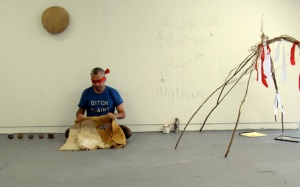
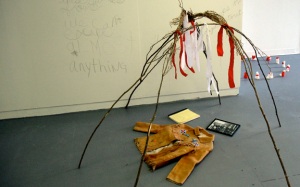

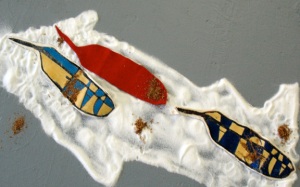
Morin quotes his grandmother “with these stories of ours we can escape almost anything.”
12 Making Objects: 12 Indigenous interventions a.k.a First Nation’s DADA, Peter Morin 2009 Artist in Residence Camosun College and Open Space, Victoria BC



